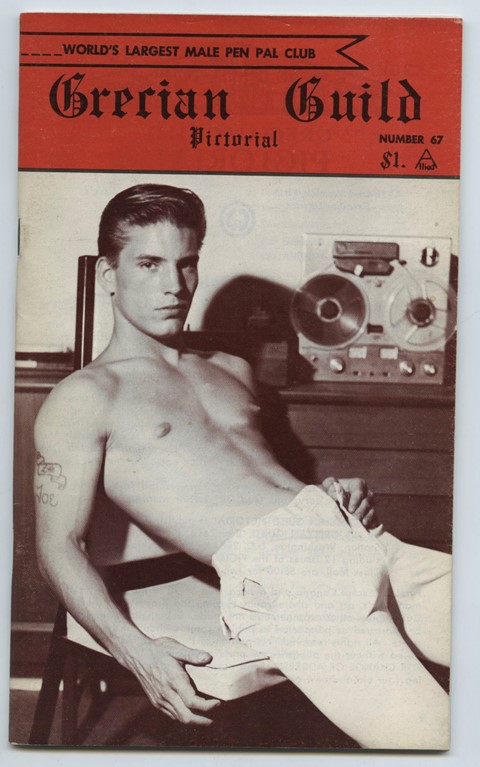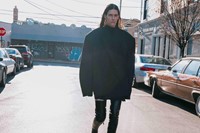The sixth edition of Tomorrow’s Man – named after a 1950s gay magazine – features works by contemporary artists alongside a heartfelt blend of archival images
Jack Pierson happened upon Tomorrow’s Man by chance in the early 90s, while perusing the displays of vintage bric-a-brac that people laid out for sale on East Village sidewalks back then. Flicking through the fabled beefcake magazine designed to fly under the radar during the 1950s and 1960s when depictions of male nudity were still a crime, Tomorrow’s Man positioned itself as a physique magazine catering to the bodybuilding scene.
Pierson hungered for more and headed over to Physique Memorabilia on 12th Street and Broadway. After being buzzed in by the proprietor, Pierson describes the feeing of being immersed into a singular world replete with red-flecked velvet wallpaper and live parrots squawking along to the music. Nestled between Footlight Records, which catered to gay men who loved show tunes, and the Strand, Physique Memorabilia satisfied collectors of printed matter at a time when such images were hard to come by. Pierson collected them in a box that sat in his Lower East Side closet for years – but loathed the idea of bringing the box on his upcoming move to the West Village.
Then opportunity knocked; Bob Gilbert invited him to be in an Art Against Aids exhibition at Paula Cooper. “I thought of minimalism and the flow of everything,” says Pierson of the moment inspiration struck. “I just gave him that box of old pornos, told him to put it on the floor of the gallery and call it, Old Friends. And it sold. A peak month for me somehow.” Pierson tapped into our enduring love for artefacts of days past, of a seeming innocence that now feels hopelessly out of reach and yet no less alluring. That romantic sensibility, along with a splash of wit, charm and insouciance, forms the core of Tomorrow’s Man, his ongoing collaboration with Bywater Bros Editions.

First envisioned as a one-off, Pierson saw that Tomorrow’s Man was a collectible. Taking its cue from The Yellow Book, a British literary periodical published in the mid-1890s, Pierson will be doing a 13-edition set. On February 21, he releases the sixth edition, which features works by contemporary artists including Jeremy Deprez, Eliza Douglas, Robert Escalera, Mark Flood, Mended Veil, and Kembra Pfahler, and more combined with a heartfelt blend of archival images that adds a splash of familiarity and warmth.
After doing a few theme issues, Pierson decided to return to an off-the-cuff approach, drawing from the things in his purview that resonated most. Among them was Instagram, where he sees gems by young artists amid the ever flowing stream of imagery. “I can remember having my first printed piece being very uplifting,” Pierson says. “It gave me confidence, and I want to provide this opportunity for people. I also try to make, like a couple of big artists that don’t need the help [for context]. It makes a difference. People still crave magazines, printed stuff. Just the Printed Matter Book Fair this year, it was like a Rolling Stone concert.”

The impulse to collect has a cult-like appeal, something Pierson had released himself from until he discovered eBay during the early days of the pandemic. “I was late to the game,” he admits. “For 20 years I was desperate not to be a collector. These people get weighed down. I have one friend that’s an obsessive record collector – and there’s nothing more depressing than the texture of albums on a shelf.”
But printed matter can be discreetly put away in flat files, out of sight, out of mind, which makes it easier to stash a simple black tear sheet from a long-forgotten magazine that Pierson has been carrying around since 1980. In a section titled Hope for Homosexuals: Teen Challenge, the writer gives readers 25 “tips” to spot a [slur], encouraging them to keep an eye out for boys “swaying hips” and “striking unusual poses”. “I love stuff from another period that speaks to me,” says Pierson. “There’s no difference between the gay bars of the 60s and 70s than people who are fascinated by Egypt. It’s just like, what was I like inside?”

The piece de resistance is One Stop, a one-act screenplay by John “Chico” Kramer III, which takes us for a ride on a Bronx-bound D train out of Coney Island Beach. “There’s a quality of guy that grew up in New York and they are just characters. They just have a way about them, super accepting and easy on the streets,” says Pierson of Chico. Seeing Chico’s love of literature, Pierson encouraged his young friend to sit down and write. The result is One Stop, which a group of NYU students decided to turn into a short film. “He got very lucky because the movie actually got made. And I was like, ‘Here's the script in print.’ See, it was worth it!”
Tomorrow’s Man 6 by Jack Pierson is out now.






